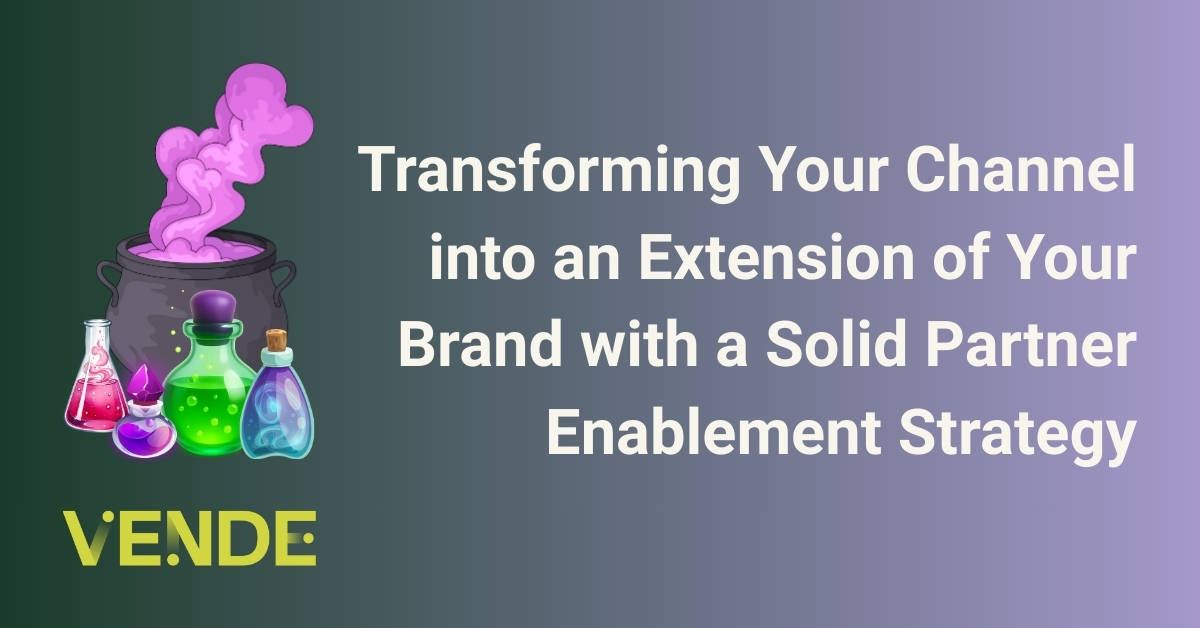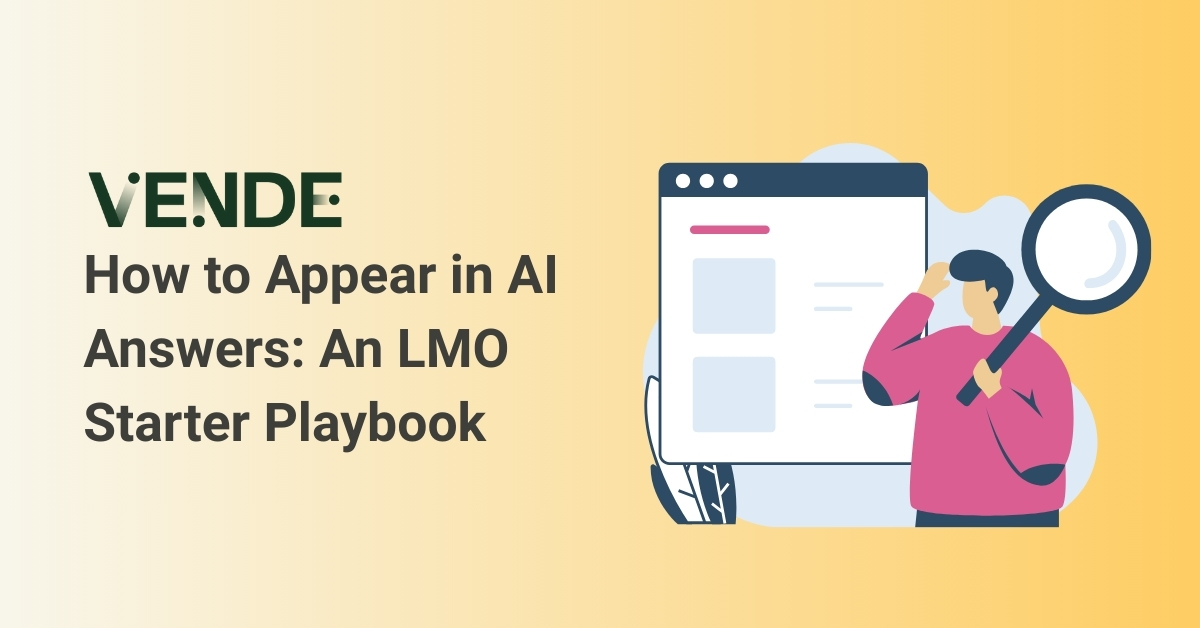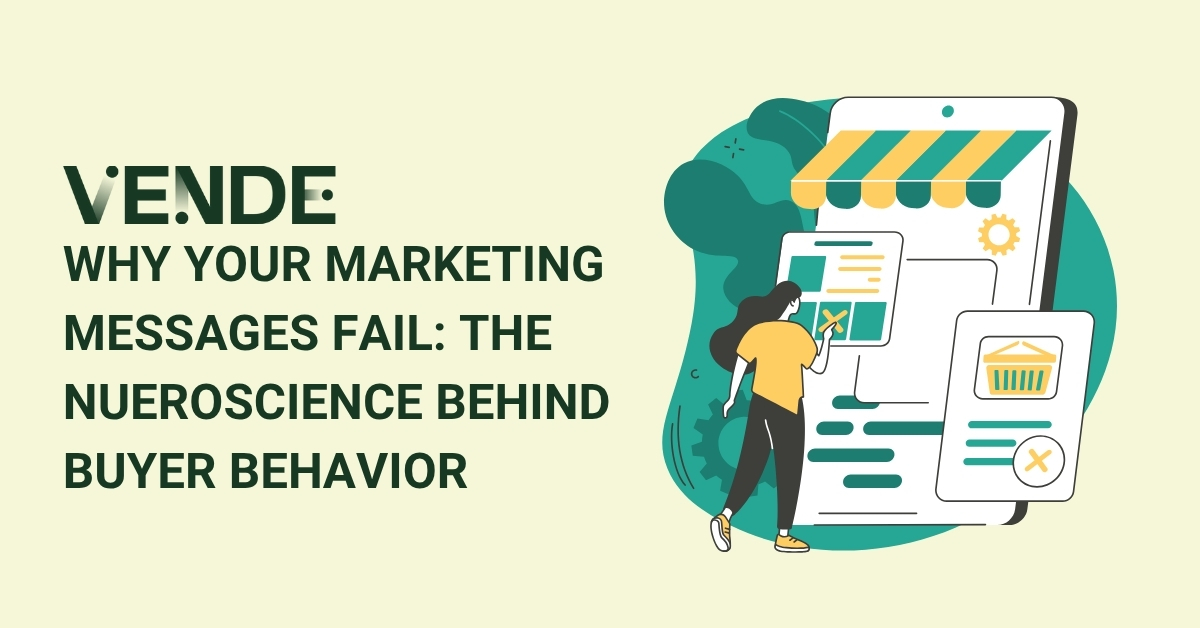
Putting the Buyer First: Implementing Buyer-Centric B2B Email Campaigns
Welcome back to our deep dive into the world of buyer-centric B2B email marketing. In the Part 1 blog post, we explored the evolution of email marketing best practices and introduced the concept of putting the buyer's needs at the forefront of our campaigns. We uncovered why traditional approaches often fall short and laid the foundation for a new, more effective paradigm.
Let’s Get Practical
Now, in Part 2, we're rolling up our sleeves and getting practical. It's time to turn theory into action. Let’s explore how to make every email an opportunity to increase customer satisfaction.
In this article, we'll walk you through the step-by-step process of crafting buyer-centric email marketing campaigns that resonate with your target audience and drive real results.
Crafting Buyer-Centric B2B Email Campaigns
Let’s explore how to create email marketing campaigns that truly resonate with your audience. As Sheri Otto stated in a recent Demand Gen Jam Session, ‘Your email messages should feel like 1:1 communication that is personable, relevant, and helpful.’ Here’s how to do just that.
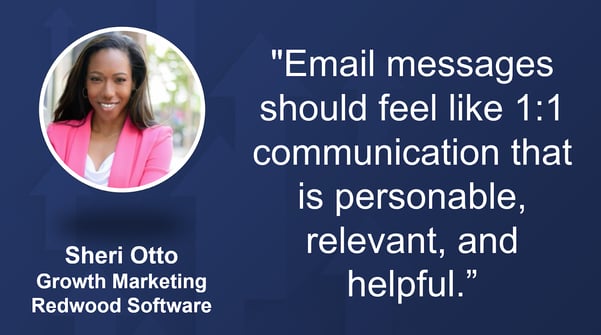
Step One: Identify Buyer Goals and Pain Points
Before crafting any email, you need to focus on four key elements of your buyer's persona:
- Goals: What is your buyer trying to achieve? This could be short-term objectives like solving an immediate problem or long-term aspirations like growing their business or advancing their career.
- Pain Points: What challenges or frustrations is your buyer facing? These are the obstacles standing between them and their goals.
- Opportunities: What potential for improvement or growth does your buyer see? This could be in their personal role, their team's performance, or their overall business.
- Constraints: What limitations is your buyer working within? This might include budget restrictions, time constraints, or organizational barriers.
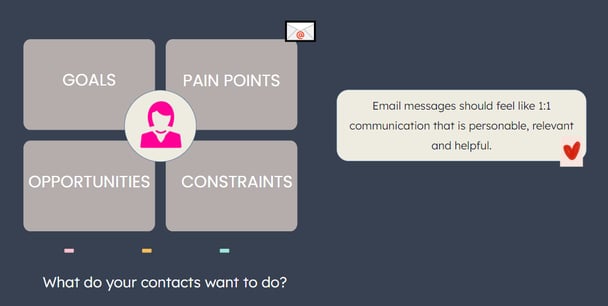
With these elements in mind, ask yourself these critical questions to better understand your target audiences’ buying process before crafting your email:
- What is my buyer trying to achieve?
- What obstacles are they facing?
- How can my product or service help them overcome these challenges?
By posing these questions, we zero in on their objectives. You can also conduct customer interviews, surveys, and data from your CRM to construct in-depth buyer personas that go beyond basic demographics.
Discover Unique Customer Insights with Our Expert Interview Guide
Get our exclusive “11 Questions to Ask Your Customers to Uncover Unique Insights.” This powerful guide will help you:
✓ Understand Your Audience: Gain deeper insights into what drives your customers and what they truly need.
✓ Craft Effective Questions: Learn the exact questions to ask to elicit detailed, actionable responses.
✓ Enhance Your Marketing Campaigns: Use real customer feedback to create campaigns that cut through the noise and grab attention.
Don’t miss out on the opportunity to transform your B2B marketing strategies with direct insights from your customers. Get your free guide now and start unlocking valuable insights today!
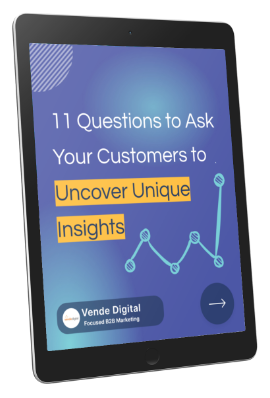
By downloading this guide, you’ll have a comprehensive resource to conduct impactful customer interviews that drive your marketing success.
Step Two: Map Email Content to Buyer Intentions
For each stage of the Jobs to Be Done framework, consider the following relevant content types:
- Discover: Help them discover your product and share how they can Learn more. You could collaborate with the SEO and product teams to develop content that attracts your ideal buyer into your ecosystem. Example content could include:
- Industry trends & reports
- Problem-focused blog posts
- Introductory webinars
- Offer exclusive insights or data
- Learn: Help them learn about your product and then share how they can evaluate it with a trial or demo when ready. Example content could include:
- Educational whitepapers
- How-to guides
- Expert interviews
- Actionable tips they can implement immediately
- Evaluate: Share how they can evaluate your expertise or solution and then show them how to take the next step with a consultation, trial, or demo when they are ready. Example content could include:
- Case studies
- Product comparisons
- Free trials or demos
- Buy: Help contacts buy your solution with social proof and sales strategies like reminding them of the cost of not taking action and answering questions, ‘Why us?’ and ‘Why now?’ Example content could include:
- Customer testimonials
- ROI calculators
- Clear next steps to purchase
- Engage: Support their activation and onboarding experience after they become a customer. Example content could include:
- Onboarding materials
- Best practice guides
- User community invitations
- Advocate: Engaging with inviting customers community. Examples that involve engaging with customers could include:
- Referral program information
- User-generated content opportunities
- Exclusive "insider" content
Pro Tip: Always provide a way for contacts to skip steps and go straight to the buying opportunity. You can simply say in your email, ‘When you’re ready, here are a few ways we can help.’
Step Three: Personalizing Beyond Just Using Names
True personalization involves creating messages that deeply connect with your audience by considering their interests, specific needs or challenges, and their position in the buyer's journey. This goes well beyond using the buyer’s name in the subject line or body of the email. The goal is for every individual receiving your email to feel as though it was uniquely crafted for them, addressing exactly what they wanted.
B2B Email Marketing Personalized to Their Needs
Genuine personalization goes beyond surface-level customization; it entails tailoring your entire message to cater to the recipient's unique requirements.
- Use AI to Generate Data-Driven Personas
- Use behavioral customer data to inform relevant content recommendations
- Segment your list based on industry, company size, and job role
- Customize your messaging based on past interactions with your brand
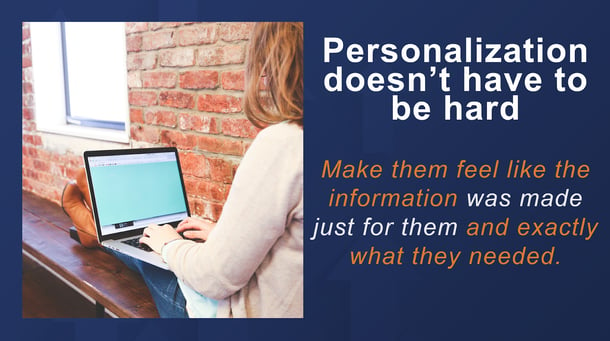
Step Four: Creating value-driven email experiences
This is where “partnering in their pursuit” really comes into play. Every email should provide value to the recipient. But what does "value" really mean in the context of B2B email marketing? It's not about flashy graphics or clever wordplay (though those can help). It's about addressing your buyers' needs, challenges, and aspirations.
Focus Your Marketing Efforts On Providing Real Value
- Shift from promoting features to solving problems - Your buyers aren't looking for a list of product specifications; they're looking for solutions to their pain points. So, instead of trumpeting how great your software's user interface is, show them how it can save them time, reduce errors, or increase productivity.
- Offer exclusive Insights—B2Bs are information-hungry and always on the lookout for that competitive edge. If you can provide them with industry insights, trend forecasts, or benchmark data they can't get elsewhere, you're not just sending an email—you're delivering valuable intelligence.
- Provide actionable tips - This could be a quick productivity hack, a checklist for improving a business process, or a template they can use in their work. The key is to make your emails interesting to read and useful in practice.
- Curate useful resources - Don't be afraid to curate content from other sources. If you come across an article, study, or tool that would be genuinely helpful for your buyers, share it. This shows that you're more interested in providing value than just promoting your own offerings.
- Format for scannability - Break up your content with subheadings, bullet points, and even visuals where appropriate. Make your emails easy to skim for those who are short on time but rich in content for those who want to dive deeper.
Leveraging Technology and Digital Marketing Tools for Buyer-Centric Emails
Technology and best-in-class email marketing software can play a crucial role in understanding and meeting buyer needs. That’s why Vende Digital is a HubSpot partner and recommends using their powerful email marketing tools.
When technology is set up the right way, you can leverage it in the following ways:
- Behavior-triggered emails: Imagine a prospect downloads a whitepaper from your website. In the past, this might have triggered a generic "thanks for downloading" email. But with advanced marketing automation, you can do so much more. You can set up workflows that respond intelligently to this action. An email with related case studies may arrive in their inbox two days later, perfectly timed to build on their initial interest.
- Dynamic content personalization: This isn't just about slapping a prospect's name at the top of an email (though that's a start) or in the subject line. It's about customizing the entire content of the email based on what we know about the recipient. Are they in healthcare or finance? Are they a small business or an enterprise? Have they engaged with our content before? Each of these factors can inform the content they receive, making each email feel like it was crafted just for them.
- Customer Data-driven AI-enabled audience segmentation: To truly scale 1:1 communication, we need to get more thoughtful about how we segment our audience. This is where AI and machine learning come into play. These technologies allow us to move beyond basic demographic segmentation to create nuanced, behavior-based segments. We're not just grouping people by job title or industry anymore; we're segmenting based on engagement patterns, content preferences, and where they are in the buyer's journey.
- Delivery time optimization: Even the most perfectly crafted email will not have an impact if it's sent at the wrong time. That's why optimal send time prediction is crucial. By analyzing when each individual recipient is most likely to engage with emails, we can ensure our messages arrive at the perfect moment.
- A/B testing: A/B testing at scale allows us to constantly refine our approach, testing everything from your subject line to content variations to CTAs across large segments of our audience.
The goal is to use technology to enhance, not replace, the personal touch. By utilizing tools like HubSpot, you can create highly efficient buyer-centric emails.
Measuring Success in a Buyer-Centric World
Forget vanity metrics like open rates. In a buyer-centric approach, success is measured by:
- Engagement rates (Are buyers interacting with your content?)
- Progression through journey stages (Are you helping buyers move forward?)
- Customer feedback (Are your emails actually helpful?)
- Business outcomes (Are your emails contributing to revenue growth?)
Remember, shifting to a buyer-centric email marketing strategy is an ongoing process. Review these metrics regularly and use the insights to refine your approach.
Case Study: HubSpot's Chatbot-Email Integration
Here’s a real-world example that Sheri Otto shared in a recent Demand Gen Jam session on aligning email marketing best practices to the buyer’s journey. This case study showcases how HubSpot successfully integrated chatbot interactions with its email marketing efforts to drive unprecedented engagement and conversions.
The Challenge:
How to effectively capture and nurture leads who engaged with their website but didn't immediately convert. HubSpot recognized that their chatbot was attracting high-intent visitors but needed to continue the conversation beyond the initial interaction.
The Buyer-Centric Solution:
Instead of treating chatbot users and email recipients as separate audiences, HubSpot decided to create a seamless experience that bridged these two channels. Here's how they did it:
- Understanding Buyer Behavior: They analyzed chatbot interactions and discovered that users valued quick, button-based responses. This insight into buyer preferences informed their email marketing strategy.
- Segmentation Based on Intent: HubSpot created a unique list of users who clicked high-intent buttons in chat, such as "tell me about the product," "learn about features," or "talk to sales."
- Tailored Email Follow-up: They designed an email marketing campaign specifically for these high-intent chatbot users, mirroring the chatbot experience they had enjoyed.
- Consistency Across Channels: The email maintained the same quick, button-based interaction style that users had appreciated in the chatbot.
- Value-First Approach: The email content focused on providing fast answers and honoring the recipient's curiosity about HubSpot's solutions.
The Results:
The outcomes of this buyer-centric, cross-channel approach were impressive:
- Open Rate: The campaign achieved a 31% open rate, significantly higher than industry standards.
- Click-Through Rate: Even more impressive was the click-through rate, which more than doubled HubSpot's average of 6%, reaching 15.52%.
- Conversion: The campaign met HubSpot's demand generation targets for qualified lead conversion rates.
- Scale: The campaign reached over 500 contacts each month.
- Pipeline Impact: Nearly 15% of recipients progressed to the sales pipeline.
Key Takeaways:
By maintaining a consistent experience between chatbot and email, HubSpot created a seamless buyer journey.
- Buyer Behavior Insights: Understanding how buyers interacted with the chatbot informed a more effective email marketing strategy.
- Respecting Buyer Preferences: By mirroring the quick, button-based interaction in emails, HubSpot honored their buyers' preferred way of engaging.
- Timeliness and Relevance: Following up quickly with chatbot users, capitalizing on their recent interest and intent.
- Focus on Buyer Needs: The campaign prioritized providing value and answers rather than pushing for an immediate sale.
This case study exemplifies the power of a truly buyer-centric approach to email marketing best practices. HubSpot significantly improved engagement and drove meaningful business results by understanding their buyers' behaviors and preferences and creating a seamless experience across channels.
As you consider your own email marketing strategy, ask yourself: How can you better align your emails with your buyers' behaviors and preferences across all touchpoints? The answer could unlock similar successes for your B2B email marketing campaigns.
Embracing the Buyer-Centric Email Marketing Revolution
As we wrap up our deep dive into buyer-centric B2B email marketing, let's reflect on the paradigm shift we've explored. This approach's key components include putting the buyer's agenda first, understanding and aligning with the buyer's journey, leveraging the Jobs to Be Done (JTBD) framework, using the ADHD approach (Attention, Direct, Human, Direction), harnessing technology, and continuously analyzing data.
This isn't just about being nice—it's practical. As the HubSpot case study shows, aligning your email strategy with your buyers' needs and behaviors can be transformative.
Reevaluate Your B2B Email Marketing Strategy
Be bold and question everything you thought you knew about B2B email marketing. The market is evolving, buyer expectations are changing, and your strategy needs to keep pace. Ask yourself:
- Are your emails truly serving your buyers or just your sales targets?
- How well do you understand your buyers' journey and their "jobs"?
- Are you leveraging technology to personalize at scale?
- How are you measuring success? Are you looking beyond open rates to understand the real impact?
Final Thought: The Power of Putting the Buyer First
Successful B2B email marketing is about genuinely understanding and serving your buyers. When you put buyers first, your emails become valuable resources, your brand becomes a trusted advisor, and your marketing drives business growth.
Every email is an opportunity to serve, add value, and build trust. Are you ready to seize it? The future of B2B email marketing is buyer-centric, and it starts with your next email. If you need help, reach out to us and schedule a consultation with one of our email marketing experts today.
